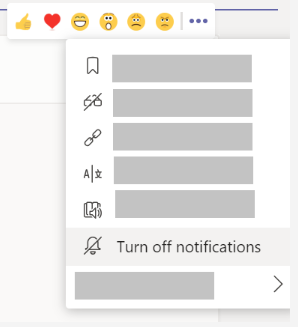I don't seem to receive any onscreen notifications for Chat or Channel messages. I do receive an email for when i do not have Teams application running, but on screen notifications for direct 1:1 Chat are just not working on Mac OS (10.13.1) I have tried changing the Notification Settings, but not. Apr 02, 2020 Microsoft Teams is your hub for teamwork in Office 365. All your team conversations, files, meetings, and apps live together in a single shared workspace, and you can take it with you on your favorite mobile device. Whether you’re sprinting towards a deadline or sharing your next big idea, Teams can help you achieve more. Microsoft Teams is a messaging platform first and foremost, and so it’s obvious that it would have customization for its chat notifications. Because this centralized.
- Microsoft Teams Desktop Notifications Mac
- Microsoft Teams Chat Notifications Mac 2016
- Add Chat To Microsoft Teams
- Microsoft Teams Notifications Sounds
- Microsoft Teams Notifications Mac
- Microsoft Teams Chat Notifications Mac And Cheese
When you need to communicate and collaborate with people outside your organization, Microsoft Teams gives you two different ways to make that happen. The first – external access (federation) – lets you find, call, and chat with users in other domains (for example, contoso.com). The second – guest access – lets you add individuals to your teams, as guests, using their email address. You can collaborate with guests as you would with any other users in your organization.
You can use both external access and guest access if you want - one doesn't preclude the other.
At a high level, here’s how to choose (for a detailed comparison, jump down to Compare external and guest access):
Microsoft Teams Desktop Notifications Mac


External access
Use external access (federation) when you need a solution that lets external users in other domains find, call, chat, and set up meetings with you. External users have no access to your organization's teams or team resources. Choose external access when you want to communicate with external users who are still on Skype for Business (online or on premises) or Skype (coming in early 2020).
External access is turned on by default in Teams, which means your org can communicate with all external domains. The Teams admin can turn it off or specify which domains to include (or exclude). To learn more, read Manage external access.
If you want external users to have access to teams and channels, guest access might be a better way to go.
Guest access
Use guest access to add an individual user (regardless of domain) to a team, where they can chat, call, meet, and collaborate on organization files (stored in SharePoint or OneDrive for Business), using Office 365 apps such as Word, Excel, or PowerPoint. A guest user can be given nearly all the same Teams capabilities as a native team member. To learn more, read Guest access in Teams.
- Guests are added to your organization’s Active Directory.
- To communicate with a guest, the guest has to be signed in to Teams using their guest account. This means that a guest may have to sign out of their own Teams account to sign in to your Teams account.
- Guest users have access to more resources in Teams - such as files, teams, and channels - than external-access (federated) users.
- The Teams admin controls everything that a guest can (or can’t) do in the Teams admin center. To learn more, read Manage guest access.
Microsoft Teams Chat Notifications Mac 2016

Add Chat To Microsoft Teams
If you're ready to turn on guest access in your organization, start with the Guest access checklist.
Microsoft Teams Notifications Sounds
Compare external and guest access
Microsoft Teams Notifications Mac
| Feature | External access users | Guest access users |
|---|---|---|
| User can chat with someone in another company | Yes | Yes |
| User can call someone in another company | Yes | Yes |
| User can see if someone from another company is available for call or chat | Yes | Yes1 |
| User can search for users across external tenants | Yes2 | No |
| User can share files | No | Yes |
| User can access Teams resources | No | Yes |
| User can be added to a group chat | No | Yes |
| User can be invited to a meeting | Yes | Yes |
| Additional users can be added to a chat with an external user | No3 | N/A |
| User is identified as an external party | Yes | Yes |
| Presence is displayed | Yes | Yes |
| Out of office message is shown | No | Yes |
| Individual user can be blocked | No | Yes |
| @mentions are supported | Yes4 | Yes |
| Make private calls | Yes | Yes |
| Allow IP video | Yes | Yes |
| Screen sharing mode | Yes4 | Yes |
| Allow meet now | No | Yes |
| Edit sent messages | Yes4 | Yes |
| Can delete sent messages | Yes4 | Yes |
| Use Giphy in conversation | Yes4 | Yes |
| Use memes in conversation | Yes4 | Yes |
| Use stickers in conversation | Yes4 | Yes |
1 Provided that the user has been added as a guest and is signed in as a guest to the guest tenant.
2 Only by email or Session Initiation Protocol (SIP) address.
3 External (federated) chat is 1:1 only.
4 Supported for 1:1 chat for Teams Only to Teams Only users from two different organizations.